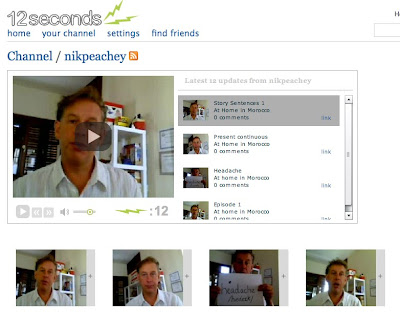Over the past couple of years online video communication has been transformed, not only price and quality, but in ease of use and accessibility. This tool has great potential for extending the reaches of our classroom and opening access to much better support for distance learners.
Video conferencing
Video conferencing was once a very difficult and expensive activity that required specific software, hardware and in many cases an expensive account with a service provider. You can now do video conferencing for free using software like Skype or free web-based services like Tokbox
Tokbox doesn’t require any downloads. You just create a free account and then star connecting with other users. You can do this by sending them a link to a conference. Using Tokbox you can:
Using Tokbox you can:
- Make live (synchronous) video calls from your computer either to one person or a small group.
- Record video messages (asynchronous) and send the by email
- Create a series of public broadcasts that anyone can access.
Here you can find some Teaching suggestions for using Tokbox with students:
Sending Video Greetings
Bubble Joy is a website that enables you to create short video greetings and then email them to people. All you need is a webcam with a microphone. The service is free and very quick and easy to use.
Annotating the web
The bubble comment site enables you to create and share a brief 90 second commentary of a website. You can use this to get students talking about and sharing their favourite sites.

 To find out more about using this tool go to: Great Video Commenting Tool
To find out more about using this tool go to: Great Video Commenting ToolVideo Microblogging
Video microblogging is a way of creating your own short video broadcasts. The first such site to enable this was 12 Seconds TV. The idea behind the site is that you create a short 12 second long video clip using your webcam. Other people can then subscribe to your channel and watch your video clips. It’s often used among friends to keep each other up to date on what they are doing, but it does have a range of uses for the EFL classroom.
  Here you can read about ways to use ‘microblogging’ with your students to create digital narrative, create vocabulary records and even practice verb forms: 12 Second Video Clips for EFL ESL
 Here you can read about ways to use ‘microblogging’ with your students to create digital narrative, create vocabulary records and even practice verb forms: 12 Second Video Clips for EFL ESL- You can see some of my examples here: http://12seconds.tv/channel/nikpeachey
- Here’s an online activity I created for students: Create a Video Vocabulary Record
I hope this gives you a few ideas and hints for how to use online video communication tools and by all means leave comments below if your own favourites haven't been mentioned here.
Related links:
- Find out about free video editing software
- YouTube for IWBs with PicLens
- Free Educational TV Channels
- Open source video animation
- News Videos for EFL ESL Materials Design
- Things You Can Do With Your WebCam 1
- Exploiting a Video Viral
- Lesson plan Top 10 Cartoons for Children’s Rights
- Create a YouTube Carousel
- Videos for Global Issues Lessons
- Update on the Education Clip Library
Nik Peachey
0 komentar:
Post a Comment